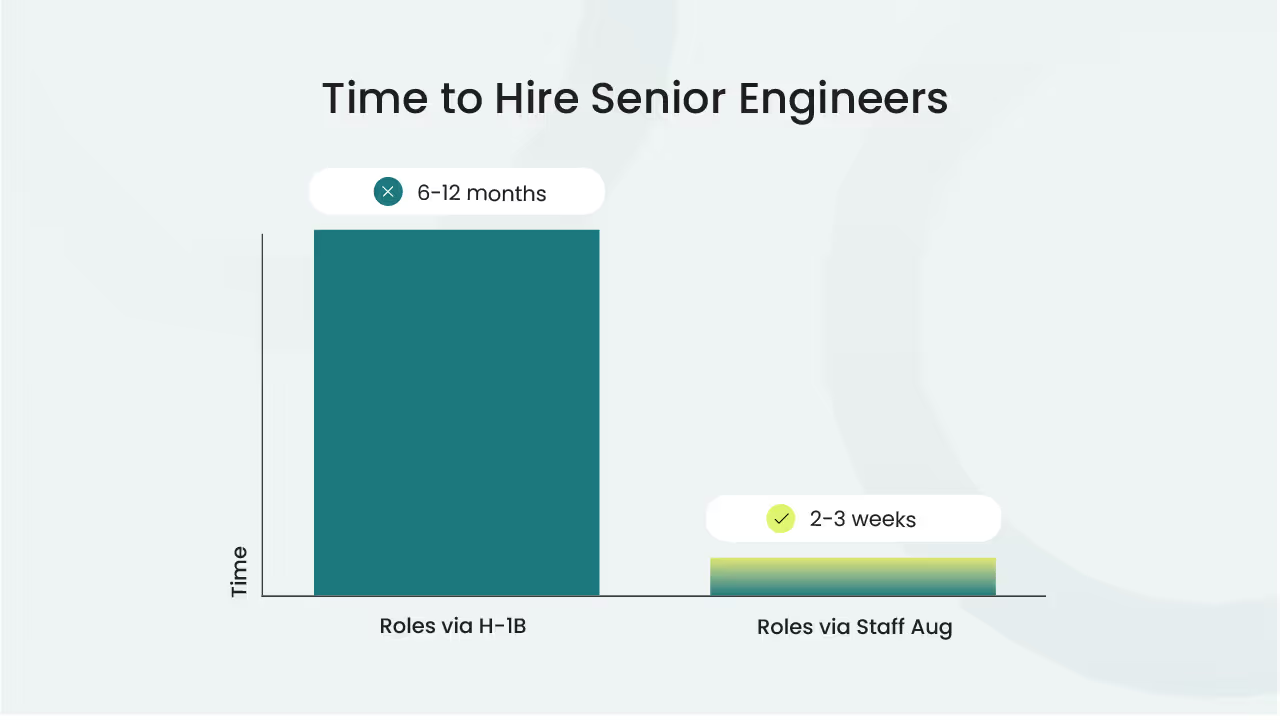H-1B Changes 2025–2030 | Staff Augmentation for Scaling Teams

📌 TL;DR
The H-1B program is getting more costly and risky, with $100,000 fees per new petition (September 2025), rising registration costs, and legal uncertainty. The stated aims are to incentivise and increase training and hiring of Americans in the long-term, however this won’t fill immediate talent gaps. Staff augmentation bridges that gap, embedding vetted engineers in 2–3 weeks at 50–75% lower cost, helping companies maintain delivery today while building a domestic pipeline for tomorrow.
The Shifting Talent Landscape
H-1B Lottery and Fee Hikes
The H-1B system has always been oversubscribed. In FY2024, USCIS received nearly 800,000 registrations for 85,000 slots, leaving most companies with nothing to show for sunk costs. The September 2025 proclamation added a $100,000 fee for new petitions filed on or after September 21, 2025, exempting extensions with the same employer but creating challenges for new hires (Fragomen, 2025).
The H-1B registration fee will rise from $10 to $215 per beneficiary starting in the FY2026 lottery, a 21x increase confirmed by USCIS (EY, 2025). For companies submitting dozens or hundreds of registrations, that adds up, but in the grand scheme, it’s marginal compared to the $100,000 proclamation fee that now applies to new petitions filed on or after September 21, 2025.
The contrast is stark: the registration hike is a relatively minor cost increase for most businesses, the $100,000 fee requires a strategic shift. Together, they underline a broader reality - the cost profile of H-1B hiring is structurally higher, and unlikely to revert before 2030.
Cap-Gap and Extensions
Some measures, like the 2024 “cap-gap” extension for F-1 visa holders transitioning to H-1B, offered temporary relief. But as rules tighten and fees escalate, even stopgap measures can’t address the growing mismatch between demand and supply.
What It Means for Scaling Teams
For CTOs and COOs, these aren’t just immigration issues. They translate into:
- Longer hiring cycles (6–12 months before productivity).
- Higher upfront costs (legal, compliance, $100k fee).
- Strategic uncertainty (policies can change overnight).
The result: delivery pipelines are at risk if companies continue to rely on H-1Bs.

Planning Horizon: 2025–2030
FY2026 and Beyond
Starting in FY2026, the economics of H-1B hiring shift decisively:
- The $215 registration fee per beneficiary takes effect, making even lottery participation a more expensive gamble.
- The $100,000 proclamation fee for new petitions remains in force unless struck down in court. Even if challenged, the uncertainty is likely to persist for several cycles.
- Lottery odds will likely remain below 30%, meaning the majority of applications will continue to result in sunk costs.
What This Means for Business Planning
From FY2026 onward, executives cannot treat H-1B hiring as a predictable capacity strategy. It becomes a high-cost, low-certainty option that should be reserved for niche roles where specialized expertise is not otherwise available. For general scaling needs, it introduces more risk than it resolves. Businesses that relied heavily on pre-September 2025 H-1B visas, will now look to mitigate short, and long term hiring risks.
The Domestic Training Pipeline: A Slow Relief Valve
Companies, universities, and governments are rightly investing in reskilling programs and STEM education. Apprenticeship and graduate recruitment initiatives are growing, but these pipelines take 5–10 years to produce mid-level contributors. McKinsey stresses that strategic workforce planning is essential to anticipate future gaps, but planning alone does not create immediate throughput (McKinsey, 2025).
By Gartner’s forecast, without new channels, global tech labor scarcity will add 15–20% to engineering costs by 2030. This means relying solely on domestic training as a substitute for H-1Bs risks prolonged cost escalation and delivery bottlenecks.
The Risks of Standing Still
If companies adopt a “wait-and-see” approach, they risk:
- Roadmap delays: product launches slip while waiting for talent.
- Missed revenue opportunities: features and services arrive later to market.
- Investor scrutiny: unpredictable hiring costs and delays undermine forecasts.
As Deutsche Bank strategist Jim Reid warned in September 2025, the proclamation “caused a huge amount of uncertainty… for those that rely on it” (Guardian, 2025).
The Bottom Line
From FY2026 and beyond, the hiring landscape will likely be defined by higher fees, longer delays, and persistent uncertainty. Domestic pipelines will build and eventually help in the medium term, but not fast enough to meet scaling needs in the next five years. Risk-conscious leaders should consider creating a dual approach, investing in long-term training while using faster, more predictable models to maintain delivery velocity.
That’s where staff augmentation comes in: the most immediate, flexible hedge against policy risk and a proven way to de-risk scaling.
Bridging the Gap with Staff Augmentation
Staff augmentation is a flexible workforce model that allows companies to extend capacity internationally with top-class professionals based in other countries, embedded into their workflows, without the delays and risks of traditional hiring. Unlike outsourcing, it keeps you in control (full definition here).
Immediate Access to Senior Engineers
With Cloud Employee, companies gain access to senior engineers in as little as 2–3 weeks. Roles that would take 6–12 months via H-1B are filled almost instantly. Our engineers undertake a rigorous CTO-led vetting process to ensure quality and fit.

Embedded, Not Outsourced
These engineers are embedded into U.S. teams, working in overlapping time zones, using the same tools and workflows. They feel like part of the core team, not an external vendor.
Compliance and Retention Handled
All HR, compliance, benefits, and retention are managed by Cloud Employee. With a 97%+ retention rate beyond two years, leaders can scale without worrying about churn or legal pitfalls.
The Two-Speed Strategy
Forward-looking CTOs and CIOs are adopting a two-speed approach to workforce planning through 2030:
- Speed Lane = Augmentation Now
- Immediate access to senior engineers.
- Clears delivery backlogs.
- Ensures product roadmaps stay on track.
- Core Lane = Domestic Talent Build-Up
- Investing in U.S. training, graduate recruitment, and apprenticeships.
- Slower pipeline, but sustainable long-term.
This blended strategy avoids binary dependency on H-1Bs. Companies keep velocity now while building resilience for the future.
Case Study
Salmon Software: Scaling and Winning at Pace
Salmon Software, a leading provider of treasury management systems, needed to scale quickly to capture new market opportunities. Their in-house team could not expand fast enough through traditional hiring. By partnering with Cloud Employee, Salmon accessed CTO-vetted engineers who integrated seamlessly into their workflows. This allowed them to accelerate product delivery, keep pace with client demands, and maintain their competitive advantage. The result was not only faster scaling but also the ability to win larger enterprise deals at speed, without compromising quality. Read the full Salmon Software case study.
Event Connections: Extending a Team at Capacity
Event Connections, an events platform, reached maximum capacity with its internal team. Hiring locally would have taken months and risked missing critical deadlines. Cloud Employee provided vetted and valuable contributors who joined the team quickly, ensuring development didn’t stall. The additional capacity meant the company could keep up with demand, deliver new features, and strengthen client confidence without burning out its core staff. Read the full Event Connections case study.
KPIs to Track Success
To prove the ROI of staff augmentation, executives should track:
- Time-to-first commit (engineer ramp-up speed).
- Sprint throughput (velocity increase after augmentation).
- Cost per shipped feature (all-in cost efficiency).
Retention rate (continuity over multiple releases).
2030 Outlook: Three Scenarios
1. Higher Fees and Uncertainty Persist
If the $100,000 proclamation fee is upheld and new restrictions are layered in, the H-1B program will likely move from a mainstream hiring strategy to a niche pathway for specialized roles only. The program’s high cost and unpredictability mean it will no longer serve as a scalable solution for building delivery teams. In this environment, tech leaders should:
- Reserve H-1B usage for hard-to-source expertise (e.g., niche AI research, cybersecurity leadership).
- Treat staff augmentation as the default strategy for throughput and velocity, since it offers predictable costs and delivery certainty.
- Redesign workforce planning so visas are a strategic exception, not the foundation.
The key takeaway: in a persistently restrictive environment, augmentation becomes not just a hedge, but the primary engine of scaling.
2. Moderate Normalization
If legal challenges succeed or policy stabilizes, fees may fall, and processing might improve. But even in a normalized state, the lottery odds remain structurally low (historically <30%), and compliance obligations still slow hiring cycles. For executives, this means:
- H-1Bs may regain some utility, but they are still slow to productivity (6–12 months) compared with augmentation (2–3 weeks).
- To maintain competitive advantage, augmentation should remain the “speed lane” while H-1Bs fill targeted, high-value roles.
- Leaders should avoid reverting to “H-1B as strategy.” Instead, integrate it into a portfolio approach to talent where augmentation ensures flexibility.
The key takeaway: even in a moderate scenario, staff augmentation remains critical because speed-to-hire has become a board-level metric under investor scrutiny.
3. Hybrid Norm (Blended Teams)
The most likely outcome is a blended model where domestic pipelines grow, H-1Bs are used selectively, and augmentation provides ongoing flexibility. This model has practical implications:
- Domestic juniors are hired and trained to build a sustainable long-term core.
- Domestic seniors provide leadership, cultural alignment, and deep institutional knowledge.
- Augmented professionals extend capacity, absorb workload spikes, and allow teams to flex without overextending budgets.
This “two-speed strategy” (speed lane + core lane) balances short-term velocity with long-term resilience. For CTOs, the focus should be on building a talent architecture that can absorb policy shocks without stalling delivery.
The key takeaway: in a hybrid world, staff augmentation isn’t a temporary fix, it’s a permanent pillar of modern workforce strategy.
Conclusion
The next five years will redefine how U.S. companies source tech talent. Whether fees rise, stabilize, or normalize into a hybrid model, the risk of depending solely on H-1Bs is now too high. Delays, compliance complexity, and investor scrutiny make it an unreliable scaling strategy.
Staff augmentation provides the bridge and the buffer: immediate, cost-efficient, and strategically flexible. It ensures that delivery pipelines never stall while domestic training investments mature.
If you’re interested in exploring staff augmentation for your development and engineering needs, book an obligation free-call, with Seb (CEO), Brooke, Shawnee Steph, or AJ to:
- Understand your hiring needs & timeline
- Walk you through our hiring model, how we Source, Embed and Retain engineers
- Answer any questions and share a few of our success stories.
No pressure. Just a clear overview of how we work, and a conversation to see if we’re the right fit for your business.
FAQs
As of September 21, 2025, new H-1B petitions require a $100,000 fee, while extensions with the same employer are exempt. Registration fees will rise to $215 in FY2026. Legal challenges may alter timelines, but companies should plan for higher costs.
Staff augmentation offers immediate access to vetted engineers (2–3 weeks), avoids visa costs, and provides predictable monthly pricing. It ensures delivery continues while long-term domestic hiring pipelines mature.
Yes. Regardless of H-1B outcomes, staff augmentation remains a hedge against delays and cost volatility, supporting hybrid models that blend domestic and augmented teams. This helps to address local talent shortages.







